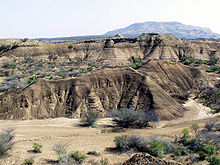Formación Omo Kibish

La formación Omo Kibish o simplemente formación Kibish es una formación rocosa en el sur de Etiopía. El nombre es por el sitio arqueológico de Omo Kibish en el río Omo, donde se estudió por primera vez. Omo-Kibish I (Omo I) es uno de los esqueletos de Homo sapiens anatómicamente más antiguos que se conoce, con una datación de 196±5 miles de años.[1]
La formación Omo Kibish y sus sitios vecinos han producido algunos de los primeros ejemplos de restos fosilizados de humanos y australopitecinos y herramientas de piedra. El trabajo de Richard Leakey allí en 1967 descubrió algunos de los restos más antiguos de Homo sapiens, humanos anatómicamente modernos.[2] Anteriormente se creía que sapiens tenía alrededor de 125 000 años, investigaciones más recientes indican que pueden datarse hace aproximadamente 199 500 años,[3] y los hallazgos de 2017, Jebel Irhoud 10 y 11 han retrasado hasta los 315± 34 ka la aparición de los humanos anatómicamente modernos.[4]
Véase también
[editar]Referencias
[editar]- ↑ Hammond, Ashley S.; Royer, Danielle F.; Fleagle, John G. (julio de 2017). «The Omo-Kibish I pelvis». Journal of Human Evolution (en inglés) 108: 199-219. ISSN 1095-8606. PMID 28552208. doi:10.1016/j.jhevol.2017.04.004.
- ↑ R. E. F. Leakey (21 de junio de 1969). «Early Homo sapiens Remains from the Omo River Region of South-west Ethiopia: Faunal Remains from the Omo Valley». Nature (en inglés) (222): 1132-1133. ISSN 0028-0836. doi:10.1038/2221132a0. Resumen divulgativo.
- ↑ «The Oldest Homo Sapiens: Fossils Push Human Emergence Back To 195,000 Years Ago» (en inglés). Consultado el 13 de abril de 2018.
- ↑ Jean-Jacques Hublin, Abdelouahed Ben-Ncer, Shara E. Bailey, Sarah E. Freidline, Simon Neubauer, Matthew M. Skinner, Inga Bergmann, Adeline Le Cabec, Stefano Benazzi, Katerina Harvati & Philipp Gunz (junio de 2017). «New fossils from Jebel Irhoud, Morocco and the pan-African origin of Homo sapiens». Nature (en inglés) 546: 289-292. ISSN 0028-0836. doi:10.1038/nature22336.
Enlaces externos
[editar]- Esta obra contiene una traducción total derivada de «Omo Kibish Formation» de Wikipedia en inglés, concretamente de esta versión del 6 de mayo de 2020, publicada por sus editores bajo la Licencia de documentación libre de GNU y la Licencia Creative Commons Atribución-CompartirIgual 4.0 Internacional.
Text is available under the CC BY-SA 4.0 license; additional terms may apply.
Images, videos and audio are available under their respective licenses.
